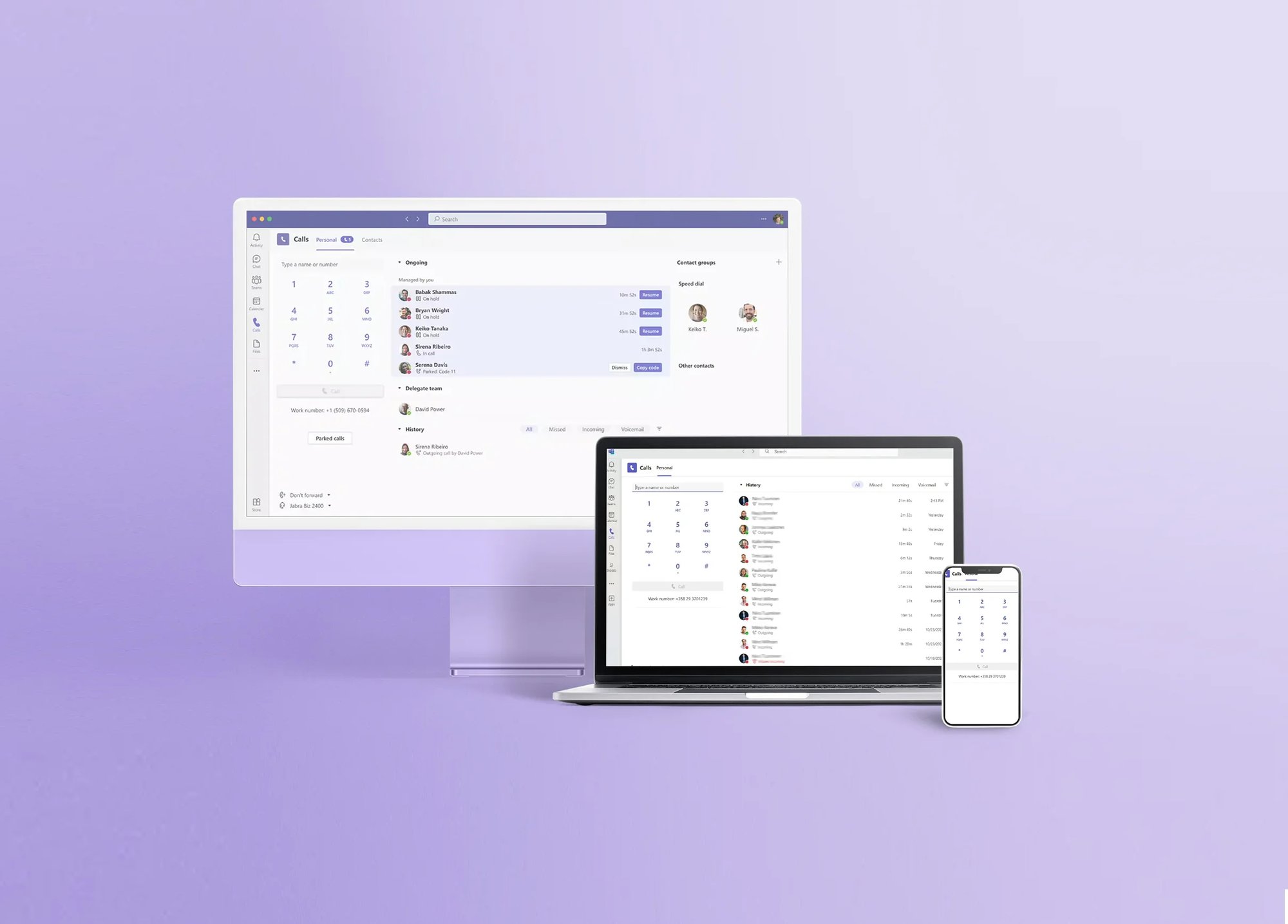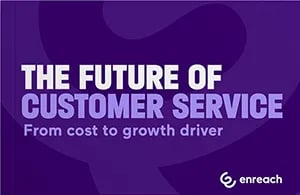Looking for a PBX?
Meet Embedded Voice—the ultimate communication solution for your entire company. It exceeds traditional PBX systems with advanced analytics and intelligent CRM-based call routing.
Get a demoWhat is a PBX?
A Private Branch Exchange (PBX) is a business phone system that facilitates calling internally and externally between different office phone extensions.
Modern PBX phone systems enable users to check voicemail, place calls on hold, and transfer calls to different extensions, enhancing communication efficiency within the organization.
Is PBX still a relevant communication solution?
While PBX systems have evolved a lot over the years, unified communication solutions are the next evolution.
Embedded Voice by Enreach is a company-wide platform offering communication tools for both enterprise and customer service users. It adapts to the needs of organisations of any size and allows employees to be available from any device regardless of location.
It transcends traditional PBX systems by integrating advanced analytics, detailed call reporting and intelligent call routing based on CRM data. In addition Embedded Voice can be integrated with Microsoft Teams.

Get access to all the PBX features you need with Embedded Voice
Embedded Voice makes managing calls simple. Set up schedules to automatically update when your team is available to take calls, enhancing responsiveness. Customize your displayed phone number to increase call pick-up rates. All calls and voicemails are tracked and easily accessible, ensuring smooth communication tailored to your business needs.

Call routing
Intelligent call routing directs incoming calls to the right department or individual based on predefined rules or caller inputs through IVR (Interactive Voice Response) systems.
Call recording
Recording of calls can be crucial for compliance, training, or quality assurance purposes. It ensures that all business communication is documented and retrievable for future reference.
Voicemail
Embedded Voice supports personalized voicemail services, enabling messages to be received when users are unavailable to take calls. This includes both individual voicemail and voicemail services for pooled service accounts.
Switchboard
Switchboards allow you to handle a large number of incoming calls that are directed to users without the assistance of a human operator. A normal service pool can be used to receive and allocate the calls to the switchboard agents.
Caller ID management
Users can change their caller ID (CLI - Calling Line Identity), which can improve answer rates by showing a familiar or local number to the recipient, enhancing the trust and response rate to incoming calls.
Service pools and queue management
Set up service pools (or queues) for managing incoming calls, which is essential for customer service centers. This feature helps in distributing calls efficiently among available team members based on criteria like idle time or skill level.
Plus advanced features that exceed standard PBX solutions
Embedded Voice meets standard PBX requirements—and improves your communication with advanced features for modern businesses like yours.
Bring voice and CRM data together
Embedded Voice works smoothly with CRM systems like Salesforce and Microsoft Dynamics 365, and tools like Microsoft Teams. Manage all your communications easily without switching apps.
Stay connected on the go
Embedded Voice brings powerful mobile capabilities and desktop solutions to your team. Access our system from any device, anywhere—perfect for remote work or when you're moving around.
Never miss a call—or a sale
Unanswered calls mean lost business. With Embedded Voice, ensure every call and every potential sale is captured.
Get a clear view of your service teams
With our group manager and supervisor tools, you can easily monitor performance and access analytics to understand how your customer service really performs.
Scale up and stay secure
Embedded Voice grows with your business. It adapts easily to your needs. Plus, it keeps your data and communications safe, ensuring your business is protected now and in the future.
Deliver better customer service
Our system uses easy voice menus, manages call flow, and connects with your customer data for smoother interactions. This leads to happier customers who stay with you longer.
Why choose Embedded Voice for your PBX needs?
Embedded Voice is perfect if you think that a PBX should do more than just connect calls. Its standout feature is seamless integration with essential business applications like CRM systems and Teams.
By blending communication seamlessly into everyday workflows, Embedded Voice enhances productivity and customer experiences. With Embedded Voice, businesses can streamline operations and maximize efficiency—all within your existing software ecosystem.

Let’s bring voice and data together
Experience a simpler way to handle your business calls and customer data with Embedded Voice. This easy-to-use solution integrates seamlessly into your operations, offering all the essential communication tools you need.
Here's what you get with Embedded Voice:
- Answer calls from any device: Whether at your desk or on the move.
- Intelligent call routing: Calls automatically go to the right person, saving time and hassle.
- Voicemail to email: Never miss a message again.
- Caller ID that works for you: Always know who's calling and why.
You can access detailed reports on call volumes and timings, which help you make smarter decisions. Embedded Voice also integrates smoothly with your existing CRM systems like Salesforce or Dynamics 365, automatically pulling in caller details during calls for more informed conversations.

Operator services: Mobile and fixed-line services over VoIP
Stay connected seamlessly with Enreach’s multinational telecom cloud. Our service combines mobile and fixed-line calls over VoIP, enabling you to manage your calls on your computer or through apps like Microsoft Teams, from anywhere and in any work setting. Our comprehensive solution also offers mobile services in regions not directly covered by us and allows for an easy switch of your existing phone number to our system.

Get your comprehensive guide to Embedded Voice
Inside the guide, you’ll find detailed breakdowns of all features, from basic call handling to advanced analytics. Learn how Embedded Voice blends PBX capabilities with advanced features to streamline your business communications.
Trusted by 100+ enterprises in the Nordics



Frequently asked questions
-
What is a PBX system?
PBX stands for Private Branch Exchange, which is a private telephone network used within a company. Users can communicate internally (within their company) and externally (with the outside world), using different communication channels like Voice over IP, ISDN, or analog.
-
How does Embedded Voice exceed traditional PBX systems?
Embedded Voice goes beyond traditional PBX systems by incorporating advanced features like CRM integration for better customer management, detailed analytics for performance tracking, and intelligent call routing to direct calls based on customer data, improving both efficiency and customer satisfaction.
-
Can Embedded Voice integrate with my existing CRM software?
Yes, Embedded Voice is designed to integrate seamlessly with major CRM software, including Salesforce and Microsoft Dynamics 365. This integration enables businesses to access customer data during calls, enhancing communication and enabling personalized service.
-
Is Embedded Voice suitable for remote or hybrid work models?
Absolutely! Embedded Voice supports remote and hybrid work models by allowing employees to be available from any device. This flexibility ensures that teams remain connected and productive regardless of their physical location.
-
What are the security features of Embedded Voice?
Embedded Voice includes robust security features such as end-to-end encryption, secure user authentication, and regular security audits to protect against unauthorized access and ensure that communications remain confidential.
-
How does Embedded Voice handle data privacy and compliance?
Embedded Voice complies with international data protection regulations, including GDPR. It includes features like data anonymization and secure data storage, ensuring that personal data is handled appropriately and with respect to privacy laws.
-
What kind of analytics and reporting does Embedded Voice offer?
Embedded Voice offers comprehensive analytics and reporting tools that provide insights into call volume, call duration, service levels, and agent performance. These tools help businesses optimize their operations and improve decision-making related to customer service.
-
How does the intelligent call routing feature work?
Intelligent call routing in Embedded Voice uses algorithms to analyze incoming calls based on CRM data and predefined rules. Calls are then automatically directed to the most appropriate agent or department, ensuring efficient resolution of customer inquiries.
-
Can Embedded Voice handle high volumes of calls?
Yes, Embedded Voice is designed to handle high call volumes efficiently, making it ideal for large organizations and call centers. It ensures minimal wait times and efficient call distribution to manage heavy traffic.
-
What is the setup process like for Embedded Voice?
Setting up Embedded Voice involves installing the software and configuring settings according to your business requirements. The process is straightforward, with support available from our technical teams to ensure smooth implementation.
-
Is there any training provided for using Embedded Voice?
Yes, comprehensive training materials and sessions are provided for new users of Embedded Voice. This training ensures that all users are comfortable with the system and can utilize all its features effectively.
-
How scalable is Embedded Voice?
Embedded Voice is highly scalable, suitable for small businesses to large enterprises. The system can easily expand in terms of user numbers and functionalities as a business grows.
-
What customer support options are available with Embedded Voice?
Embedded Voice offers several customer support options, including technical support, online help center, and dedicated account managers for enterprise clients.
-
What are the costs involved with implementing Embedded Voice?
The costs for Embedded Voice vary based on the features and scale of deployment. Pricing models include monthly subscriptions or annual licensing, with additional costs for custom features or higher-tier plans.
-
What is a cloud PBX?
A cloud PBX, or Cloud-based Private Branch Exchange, is a phone system hosted in the cloud rather than on-premises. It leverages VoIP (Voice over Internet Protocol) technology to handle voice communications over the internet. With a cloud PBX, businesses can access advanced features like call routing, voicemail, and conferencing, all managed remotely through a web interface.
-
What is a virtual PBX?
A virtual PBX, also known as a hosted PBX or cloud PBX, is a phone system that operates entirely over the internet. Unlike traditional PBX systems, which require physical hardware on-site, a virtual PBX is hosted by a third-party provider and accessed remotely through an internet connection. It offers features like call forwarding, voicemail, and auto-attendants, making it an ideal choice for businesses seeking flexibility and scalability in their communication infrastructure.
-
What is a multi line phone system?
A multi line phone system, also known as a telephone switchboard or telephone exchange, allows multiple phone lines to be connected to a single device, enabling efficient call handling and management within an organization.
-
How does a telephone switchboard work?
A telephone switchboard, or multi line phone system, routes incoming and outgoing calls to the appropriate extensions within an organization. It acts as a central hub for managing communication flow, ensuring seamless connectivity between callers and recipients.
-
What are the benefits of using a telephone exchange?
By utilizing a telephone exchange or multi line phone system, businesses can streamline communication processes, enhance customer service, and improve overall efficiency. With features like call routing, voicemail management, and call monitoring, organizations can optimize their communication infrastructure for greater productivity.

